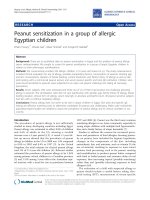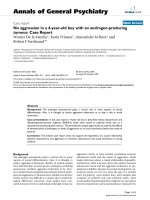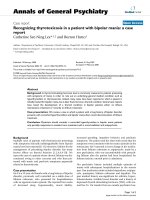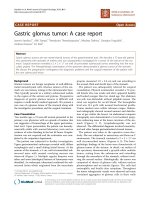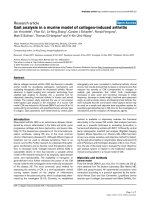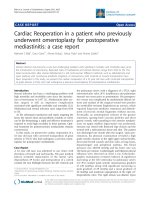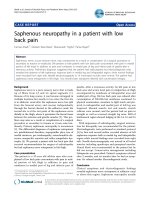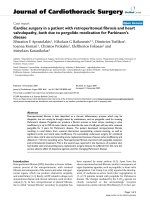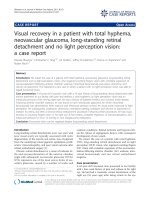Báo cáo y học: " Methemoglobinemia presenting in a circumcised baby following application of prilocaine: a case report" pptx
Bạn đang xem bản rút gọn của tài liệu. Xem và tải ngay bản đầy đủ của tài liệu tại đây (219.73 KB, 3 trang )
CAS E RE P O R T Open Access
Methemoglobinemia presenting in a circumcised
baby following application of prilocaine: a case
report
Hatice Ozdogan, Selcan Osma, Gozde B Aydin
*
, Avni Dinc, Gulten Ozgun
Abstract
Introduction: Local anesthesia with prilocaine has become a routine part of ambulatory circum cision procedures.
Methemoglobinemia is a rare but potentially lethal complication of local anesthetics.
Case presentation: We report the case of a 40-day- old Turkish boy who presented with cyanosis after receiving
local anesthesia with prilocaine. His methemoglobin level revealed severe methemoglobinemia (methemoglobin =
44%). His cyanosis resolved after intravenous administration of methylene blue.
Conclusion: Although the association between prilocaine use and methemoglobinemia has generally restricted
the use of prilocaine in babies, it is still widely used in ambulatory procedures, especially during circumcision in the
neonatal period. Prilocaine should not be used in babies who are less than 3 months old because of the risk of
methemoglobinemia; other local anesthetics may be used for this age group. Furthermore, general anesthesia by
mask ventilation may be favored for babies less than 3 months of age instead of local anesthetics.
Introduction
Circumcision is the surgical removal of the foreskin of
the glans penis. Newborns undergoing circumcision
demonstrate objective, measurable evidence of pain, yet
the procedure is often performed without analgesia.
Newborn circumcision is reported t o be the most com-
mon elective surgical procedure performed on infants in
the United States [1]. There is still significant contro-
versy regarding the benefits and risk s of newborn cir-
cumcision. In recent years, a number of authors have
reported medical benefits of newborn circumcision
including a decrease in the num ber of infants with urin-
ary tract infections, p rotection against penile cancer,
protection against HIV infection and protection against
transmission of human papilloma virus [1].
Anesthesia is not routinely admin istered for neonatal
circumcision for a variety of reasons, for example, the
relatively short duration of the intervention, the per-
ceived lack of importance of the pain, and concerns
regarding possible toxicity of the medication [2].
Administration of anesthesia attenuates acute
circumcision pain and can prevent or reduce some of
the short-term and long-term behavioral effects [3]. For
many y ears, it has been suggested that newborn infants
or neonates were unable to feel pain because of their
immature nervous system. Nowadays, it is commonly
accepted that newborn infants can feel pain and should
be treated with that taken into consideration [4].
Local anesthesia infiltration by injection is considered
to be the most effective method of analgesia for circum -
cision. The method most commonly used to administer
the anesthetic is the dorsal penile nerve block (DPNB),
first described in 1978 [3]. Local anesthesia with prilo-
caine has become a routine part of ambulatory circum-
cision procedures [5]. Methemoglobinemia is a rare but
potentially lethal complication of local anesthetics. The
iron in hemoglobin is normally in the reduced, ferrous
state (Fe
2+
), w hich is essential for its oxygen-transport-
ing functio n. Under physiological conditions, there is a
slow, constant loss of electrons to release oxygen and
the ferric (Fe
3+
) form combines with water, producing
methem oglobin. The predominant intracellular mechan-
ism for the reduction of methemoglobin is cytochrome
b5, and only 1 to 2% of hemoglobin is normally in the
ferric state. As methemoglobin levels increase, oxygen
* Correspondence:
Department of Anesthesiology and Reanimation, Dışkapı Yıldırım Beyazıt
Training and Research Hospital, Ulus Dışkapı, Ankara, Turkey
Ozdogan et al. Journal of Medical Case Reports 2010, 4:49
/>JOURNAL OF MEDICAL
CASE REPORTS
© 2010 Ozdogan et al; licensee BioMed Central Ltd. This is an Open Access article distributed under the terms of the Creative
Commons Attribution License (http://creativecommon s.org /licenses/by/2.0), which permits unrestricted use, distribution, and
reproduction in any medium, provided the original work is properly cit ed.
delivery to tissues is impaired and cellular hypoxia
develops [6]. Infants are particularly vulnerable to hemo-
globin oxidation because their cytochrom e b5 reductase
level is a pproximately 50% of the adult value [6]. We
report a patient with prilocaine-induced acquired
methemoglobinemia and discuss the use of intravenous
methylene blue treatment.
Case presentation
A 40-day-old Turkish boy weighing 4000 g was admitted
to the emergency department with cyanosis. On admis-
sion, no abnormality was detected other than central
and periphera l cyanosis and anxiety. His medical history
was unremarkable; he was born full term and had no
perinatal pr oblems. The history obtained from his par-
ents revealed that he had undergone a circumcision pro-
cedure with local anesthesia, and cyanosis had begun 1.5
hours after the procedure. A dorsal nerve block with 1.5
mg/kg prilocaine (Citanest 2%; Astra-Zeneca) was
applied during circumcision. His hemoglobin level was
11.9 g/dl and his white blood cell count was 11,200/
mm
3
. The arterial blood gas analysis revealed pH 7.28,
PO
2
85 mmHg, and oxygen saturation 78%. Electrophor-
esis revealed methemoglobin levels of 44%. 100% oxygen
was given but the patient did not respond to supple-
mental oxygen. He was diagnosed as having methemo-
globinemia; underlying erythrocyte-methemoglobin
reductase def iciency and glucose-6-phosphate dehydro-
genase deficiency were ruled out and 1 mg/kg methy-
lene blue was given intra venously. His cyanosis resolved
in 60 minutes and the methemoglobin fraction regressed
to 4% in 60 minutes and oxygen satu ration increased to
92%. The methemoglobin fraction regressed to 1.5% in
24 hours. His cyanosis disappeared completely after 120
minutes.
Discussion
Circumcision is widely used in Turkey because of reli-
gious tradition. Newborn babies are particularly s uscep -
tible to methemogl obinemia as it is related to high
levels of fetal hemoglobin, which is more readily oxi-
dized to the ferric state than is adult hemoglobin. Also
the transient deficiency of cytochrome b5 reductase
enzyme activity that persists for the first 3 to 4 months
of life favors the development of methemoglobin in neo-
nates [7].
Methemoglobinemia results from oxidation of ferrous
iron (Fe
2+
) to ferric iron (Fe
3+
), and renders the hemo-
globin molecule unavailable for oxygen transport, result-
ing in potentially life-threatening hypoxemia. Under
physiological conditions, methemoglobin reduction is
accomplished mainly by red cell nicotinamide adenine
dinucleotide (NADH)-cytochrome b5 reductase
(NADH-methemoglobin reductase) thus ensuring that
there are insignificant amounts of methemoglobin in the
circulating b lood. This enzyme pathway is immature in
neonates, therefore this disorder may be triggered by
oxidation agents such as anesthetics used in minor sur-
gical procedures such as circumcision [8,9]. The local
anesthetic prilocaine (amide group) is a popular choice
for penile blockade in circumcision owing to its short
onset time and low incidence of cardiac and central ner-
vous system toxicity. However, prilocaine is the most
potent methemoglobin-forming local anesthetic [7].
Cyanosis is the first clinical event when methemoglo-
bin levels reach ≥ 10%, but symptoms of hypoxemia and
diminished oxygen transport do not appear until levels
increase to 30 to 40%. Levels >70% may cause death [7].
Seizures, cardiovascular collapse and coma are seen with
higher methemoglobin fractions [6]. Methemoglo bine-
mia should be considered in differential diagnosis of a
child with cyanosis [5].
Pulse oximetry is inaccurate and unreliable in patients
with high methemoglobin fractions. Pulse oximetry mea-
sures light absorbance at two wavelengths (660 nm and
940 nm). Pulse oximeters do not detect methemoglobin
and the distinction of hypoxia and methemoglobin is
not possible, which may give a false impression of
patient oxygenation. A low oxygen saturation by pulse
oximetry measured in patients with normal arterial
blood gases can be an indication of methemoglobinemia.
The exact measurement is only possible using a CO-oxi-
meter [10].
For methemoglobinemia caused by drug exposure, the
traditional first-line treatment consists of an infusion of
methylene blue, the action of which depen ds on the
availability of reduced nicotinamide adenine dinucleotide
phosphate (NADPH) within red blood cells. After an
acute exposure to an oxidizing agent, treatment should
be considered when methemoglobin reaches 30% in an
asymptomatic patient and 20% in a symptomatic patient.
Patients with anemia or cardiorespiratory problems
should be treated at lower levels of methemoglobin.
Methemoglobinemia due to methemoglobin M does not
respond to ascorbic acid or met hylene blue. Methylene
blue (1% solution 1-2 mg/kg) is an oxidant, its metabolic
product leucomethylene blue is a reducing agent. There-
fore, large doses of methylene blue may result in higher
levels of methylene blue than of leucomethylene blue,
which will result in hemolysis and, paradoxically, methe-
moglobinemia in patients with glucose-6-phosphate
dehydrogenase (G6PD) defic iency [11]. In addition,
patients with G6PD deficiency may not prod uce suffi-
cient NADPH to reduce methylene blue to leucomethy-
lene blue; thus, methylene blue therapy may be
ineffective in these patients [11].
Methemoglobinemia in neonates has be en reported
after prilocaine penile ring blocks for circumcision and
Ozdogan et al. Journal of Medical Case Reports 2010, 4:49
/>Page 2 of 3
also occasionally after the use of EMLA (eutectic mix-
ture of lidocaine and prilocaine) cream [12]. There are
multiple reducing pathways that maintain levels of
methemoglobin. Although the predominant intracellular
mechanism for the reduction of methemoglobin is cyto-
chrome b5, adult levels of the enzyme are reached by 2
to 3 months of ag e. Ascorbic acid (300 mg/kg) is a
potent antioxidant and reducing agent. It directly
reduces methemoglobin but the rate is too slow for it to
be effective [13]. Although under physiological condi-
tions, ascorbic acid-induced methemoglobin reduction is
less important than reduction by the NADP-dependent
methemoglobin reductase system , under methemo globi-
nemic conditions, treatment with ascorbic acid is possi -
ble. Ascorbic acid is widely available and due to its
effect on scavenging free radicals, it can be recom-
mended as an alternative.
Guay [14] summarized all episodes of local anesthetic-
related methemoglobinemia found in the medical liter a-
ture. He found 242 episodes (40.1% pu blished in the
year 2000 or after) concerning local ane sthetics and
methemoglobinemia. He reported that plain prilocaine
may i nduce clinically sympto matic methemoglobinemia
in children older than 6 months at doses excee ding 2.5
mg/kg. Also in adults, the dose of prilocaine should be
kept lower than 5.0 mg/kg, which is reduced to 3.2 mg/
kg in the presence of renal insufficiency and to 1.3 mg/
kg if other oxidizing dr ugs are used concurre ntly. He
concluded that prilocaine should not be used in children
younger than 6 months, in pregnant women, or in
patients taking ot her oxidizing d rugs. The dose should
be limited to 2.5 mg/kg.
Conclusions
As methemoglobinemia is a rare but potentially lethal
complication of local anesthetic, physicians should iden-
tify patients who are at increased risk of developing
methemoglobinemia before administering local anes-
thetic. Prilocaine should not be used in infants less than
3 months of age because of the risk of methemoglobine-
mia. Methylene blue is the treatment of choice, but
ascorbic acid can also be considered in treatment [5].
General anesthesia by mask ventilation rather than loc al
anesthetic may be favored in infants younger than 3
months old.
Consent
Written informed consent was obtained from the
patient’s parents for publication of this case report and
any accompanying images. A copy of the written con-
sent is available for review by the Editor-in-Chief of this
journal.
Abbreviations
DPNB: dorsal penile nerve block; EMLA: Eutectic Mixture of Lidocaine and
Prilocaine; G6PD: glucose-6-phosphate dehydrogenase; NADH: nicotinamide
adenine dinucleotide; NADPH: nicotinamide adenine dinucleotide
phosphate.
Acknowledgements
Erdinc Aydın MD is thanked for editorial assistance.
Authors’ contributions
OH and OS performed patient care, analyzed and interpreted the patient
data. AGB was a major contributor in writing the manuscript. DA and OG
have given the final approval of the manuscript. All authors read and
approved the final manuscript.
Competing interests
The authors declare that they have no competing interests.
Received: 8 January 2009
Accepted: 10 February 2010 Published: 10 February 2010
References
1. Razmus IS, Dalton ME, Wilson D: Pain management for newborn
circumcision. Pediatr Nurs 2004, 30(5):414-417.
2. Stolik-Dollberg OC, Dollberg S: Bupivacaine versus lidocaine analgesia for
neonatal circumcision. BMC Pediatr 2005, 5(1):12.
3. Taddio A: Pain management for neonatal circumcision. Paediatr Drugs
2001, 3(2):101-111.
4. Essink-Tjebbes CM, Hekster YA, Liem KD, van Dongen RT: Topical use of
local anesthetics in neonates. Pharm World Sci 1999, 21(4):173-176.
5. Boran P, Tokuc G, Yegin Z: Methemoglobinemia due to application of
prilocaine during circumcision and the effect of ascorbic acid. J Pediatr
Urol 2008, 4(6):475-476.
6. Wright RO, Lewander WJ, Woolf AD: Methemoglobinemia: etiology,
pharmacology, and clinical management. Ann Emerg Med 1999,
34(5):646-656.
7. Sivasli E, Gursoy T, Yurdakok M: Which local anesthesia should be used in
neonatal circumcision in newborns?. Saudi Med J 2005, 26(4):690-691.
8. Aepfelbacher FC, Breen P, Manning WJ: Methemoglobinemia and topical
pharyngeal anesthesia. N Engl J Med 2003, 348(1):85-86.
9. Mansouri A, Lurie AA: Concise review: methemoglobinemia. Am J Hematol
1993, 42(1):7-12.
10. Rudlof B, Lampert R, Brandt L: The use of pulse oximetry in prilocaine
induced methemoglobinemia. Anaesthesist 1995, 44(12):887-891.
11. Rehman HU: Methemoglobinemia. West J Med 2001, 175(3):193-196.
12. Couper RT: Methaemoglobinaemia secondary to topical lignocaine/
prilocaine in a circumcised neonate. J Paediatr Child Health 2000,
36(4):406-407.
13. Dunne J, Caron A, Menu P, Alayash AI, Buehler PW, Wilson MT, Silaghi-
Dumitrescu R, Faivre B, Cooper CE: Ascorbate removes key precursors to
oxidative damage by cell-free haemoglobin in vitro and in vivo. Biochem
J 2006, 399(3):513-524.
14. Guay J: Methemoglobinemia related to local anesthetics: a summary of
242 episodes. Anesth Analg 2009, 108(3):837-845.
doi:10.1186/1752-1947-4-49
Cite this article as: Ozdogan et al.: Methemoglobinemia presenting in a
circumcised baby following application of prilocaine: a case report.
Journal of Medical Case Reports 2010 4:49.
Ozdogan et al. Journal of Medical Case Reports 2010, 4:49
/>Page 3 of 3
